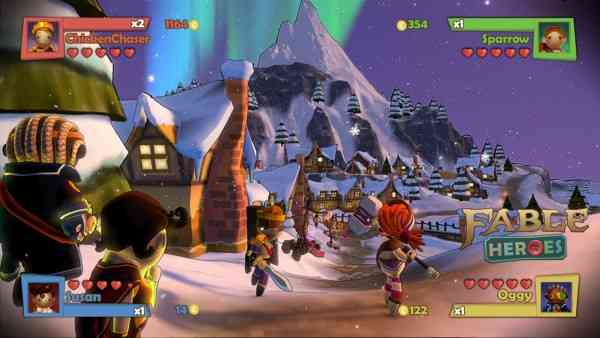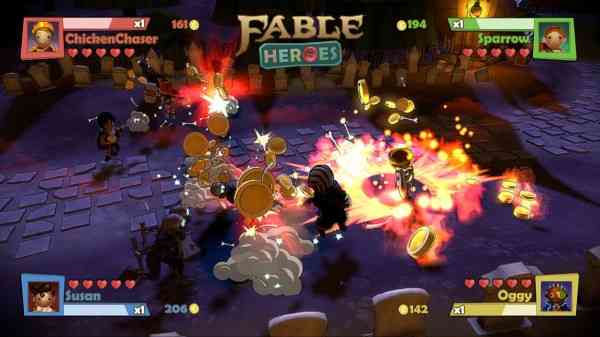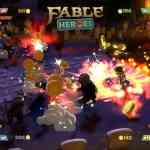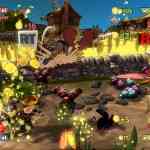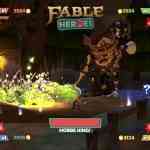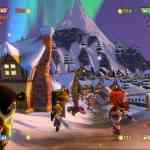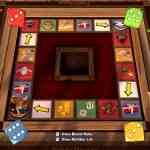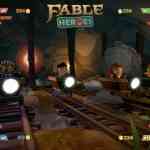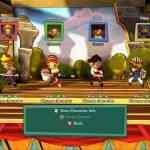I have to admit that I am a huge fan of Castle Crashers, a 4 player cooperative hack n’ slash game. It was such a big hit on XBLA and something that I played over and over again. Heck, I still pick it up now and then and mindlessly take my green or pink knight for a run through various levels. When Microsoft announced Fable Heroes I was very interested in it given its’ design and the 4 player cooperative aspect seemed right up my alley. Well the game has been on XBLA for a few days now and after taking some time with it I have to truly say that it is not the game I was expecting.
Fable Heroes is part hack n’ slash, part RPG, part Mario-party. It is quite an interesting mix to say the least. There is no particular story to talk about as your main goal is to make it through all the various levels offered while killing enemies, opening creates and collecting coins. It is very simple gameplay for sure, almost to simple.
You can choose from an initial, but nice, selection of characters. Immediately you’ll see that the different characters do manage to have varying the types of combat, such as ranged or melee, but the combat you engage in with each is limited to button mashing, charging up your attacks, and getting out of harms way. You also can use some pretty powerful special attacks too, but the trick to these is that each time you use your power attack you lose one of your five hearts that make up your health bar. It is definitely a risk/reward system here, and I found that I wasn’t willing to lose any health, as I tended to be more conservative.
The gameplay in Fable Heroes can get tired pretty quickly. Now many of you who have played Castle Crashers may say that gameplay is similiar, and you are right, but the charm of playing it is much more captivating then Fable Heroes. I don’t know what it is, but in the end I just didn’t feel as enamored with Lionhead’s game as I did with The Behemoth’s, and this is something I felt took away from the whole experience of Fable Heroes.
Adding to the experience of battle is that you collect coins as you make your way through the levels, and man there are lots of opportunities to collect coins. Coins are awarded when you defeat an enemy as well as when you smash crates that are found all over Albion. Of course like many coin-collecting games, should you beat enough enemies without dying you earn a multiplier bonus that allows you to collect even more loot….errr, coins.
One thing I found was that dying was not a punishment but more of an untimely pause in gameplay. You’ll find that when you die it really does not have an affect on your character’s performance, so dying is not all the much of an issue in the end as you’ll see be able to fight the same way (e.g. strength) as you did before you died. This was an interesting gameplay mechanic as here the risk/reward of going that extra mile to collect more coins then your cooperative partners was not as detrimental, as after you die your character is still fairly strong when you came back to life.
As you make your way through the games various levels you’ll find that each level does not feel particularly different then the one you just finished. Each level plays very similar to one another. This was disappointing given that when I played Castle Crashers each level felt different both visually and gameplay wise. Level design in Behemoth’s game is truly better, and for those that think the comparison is unfair, get over it as you can’t help but compare the two games to each other.
As you reach the end of each level you are presented with a choice of which path to take to end the level. You can choose to fight the level’s end-boss or you can play some mini-games. The latter choice is where the Mario-party feel to the game comes in. You will play various events such as some QTE boat or mine-cart races, and there is even a chicken-kicking contest. As for the bosses, you’ll find that these are somewhat stereotypical as you fight a large character that jumps around the level trying to flatten you, and they will spawn some of their own minions now and then too. These boss battles can last longer then you’d like, and in many ways they felt tacked on and could be a drag to play. Regardless, if you choose to fight the boss or play a mini-game at the end, you’ll be rewarded with even more coins once you are done.
So, I am sure you are thinking, “What are all the coins for?” When you complete a level you play a board game where all four of you who are playing throw a dice for a chance to land on a space that rewards you with one of 39 gameplay elements, from bonuses such as more damage, new skins for your weapon, to unlockable characters. This is where the RPG element somewhat plays its’ hand; however, this aspect of the game is strictly a game of chance as you never know where you are going to land and you may feel like you wasted your hard earned coins landing on a square that you really didn’t want too. Add to this should you land on an improvement or bonus of something that does not exist for your character yet, then too bad so sad, you lose that roll. Why Lionhead made this aspect of the game rely on a dice roll is beyond me, as the ability to choose your upgrade as opposed to hoping you land on it would have been more enjoyable and more RPG’ish then what is offered here.
Once you finish the game, you’ll find that Dark Albion opens up. Dark Albion is much darker and more stylized then the version of the Albion you completed to get there. It is also more difficult and adds a greater challenge to the game you just beat. For those wondering how long it will take to finish your first play through, it will take you anywhere from 2-3 hours depending on if you play alone, with friends, and how good you and your fellow gamers are. There is some replayablity in the game given that you’ll have a chance to make your way through Dark Albion, and if you want to collect all the abilities and bonuses on the board game at the end of each level you’ll need to go through the game more then a few times that is for sure; but the question remains is that will you want to?
Visually I have to say that I was really pleased with how the style and presentation of Fable Heroes ended up. It is something right out of a comic book. With bright colours, different looking levels, some nice special effects, and some great use of lighting and cel-shading, I have to give props to Lionhead for their artistic creativity in this re-interpreted world of Albion. All the characters are based on those from the previous RPG games too, but in rag doll form. They are quite cute to see. Fans of the series should get a kick how Lionhead took such a light heated approach to the visual look as it really does work here.
As with the visuals, the sound is very stylized, but unlike the visuals it is a hit and miss affair. The voices are high pitched in an effort to match the cute visuals, and although they do match the visual style they manage to grate you more often then you’d hope. As for the music it matches the on-screen art style that the game takes, and manages to make each level feel its own too. Finally, the sound effects convey and keep up with the on-screen action with ease, from swords swinging, enemies getting whacked, to the sound of your character making a leap from harms way. As a whole the sound is not as strong as the visuals, but it still manages to do a pretty good job.
As a single player game Fable Heroes can be fun, if not drawn out. Add a few more players and you’ll probably enjoy it a bit more, but again, it can still feel drawn out and start to feel more of a grind toward the end. As I sit here writing this conclusion, I find it hard to really recommend this game as a must buy given that it does nothing to push the hack n’ slash genre forward, and it really only stands as an average game at best. In the end if you are looking for something to celebrate the world of Fable, this may something to look at, but for those looking for the next Castle Crashers like experience (the comparison is inevitable) you may want to try the demo before shelling out 800 MS Points for it.
